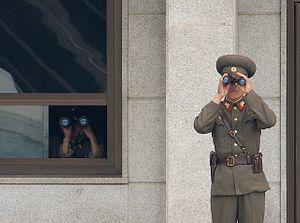The U.S. Department of Defense released its annual report on the state of North Korea’s military earlier this month. The short 22-page document paints a picture of a North Korean military that is slowly atrophying under a lack of funding. Nevertheless, the report begins by acknowledging that North Korea “remains one of the United States’ most critical security challenges.” The reason for that status isn’t its military might but its proclivity to act erratically, provoking South Korea, and Pyongyang’s “willingness to proliferate weapons in contravention of United Nations Security Council Resolutions.”
The DoD’s report is quite dismissive of North Korea’s actual hardware – the report states that the DPRK’s military technology is “outdated.” Despite this, North Korea continues to field a large military (especially for its population and GDP) that is forward-position, ready to strike South Korea with scant warning. The Pentagon sees the immense risk in this scenario despite the North’s hardware shortcomings.
A lack of funding doesn’t capture the entire reason the DoD is complacent regarding North Korea’s hardware. The report notes that military parades in Pyongyang over the last 3 years have showcased new weapon systems including tanks, artillery, and armored vehicles. The bigger reason the DoD isn’t impressed and continues to regard North Korea as a threat primarily due to the size of its military and its erratic behavior is that most of its hardware is legacy. This is most apparent in the report’s focus on the North Korean Air Force (NKAF). The NKAF still flies MiG-21s, with the MiG-29 being its most capable combat aircraft. Despite a 1,300 aircraft fleet, the NKAF “increasingly relies on its ground-based air defenses and on hiding or hardening of assets to counter air attacks.”
As far as strategic matters go, the Pentagon sees no reason to suspect that Kim Jong-un will revise the priorities his father set out for the Korean People’s Army:
Under Kim Jong Il, DPRK strategy focused on internal security; coercive diplomacy to compel acceptance of its diplomatic, economic, and security interests; development of strategic military capabilities to deter external attack; and challenging the ROK and the U.S.-ROK Alliance. We anticipate these strategic goals will be consistent under North Korea’s current leader, Kim Jong Un.
What’s interesting is the report’s focus on North Korea’s tactical shift towards offensive cyber operations (OCO) and other asymmetric tactics. Necessity is the mother of invention for the North Korean military – because it is low on funds and unable to modernize its conventional hardware, it has begun devoting more resources to cyberwar. The Pentagon details how North Korea was involved in distributed denial of service (DDoS) attacks against South Korean targets and more complex data erasure attacks against South Korean critical infrastructure in 2013.
The report concludes on cyber:
Given North Korea’s bleak economic outlook, OCO may be seen as a cost-effective way to develop asymmetric, deniable military options. Because of North Korea’s historical isolation from outside communications and influence, it is also likely to use Internet infrastructure from third-party nations. This increases the risk of destabilizing actions and escalation on and beyond the Korean Peninsula.
The Pentagon’s report suggests that North Korea’s provocative actions will become increasingly localized, allowing it to condition its neighbors without risking the possibility of a major conflagration on the Korean peninsula. Its nuclear and ballistic missile programs continue to serve as an important element of its security thinking, but its conventional hardware isn’t up to snuff.

































